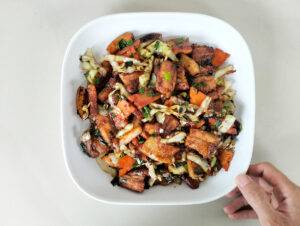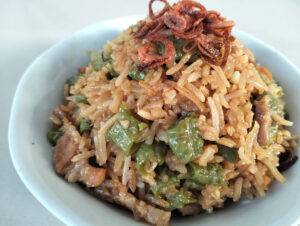Table of Contents
Creating Miso Braised Pork Belly with Daikon: The Story Behind the Dish
Last few weeks, I had the most fantastic holiday in Japan, spending a week exploring the vibrant country.
During my journey, I enjoyed discovering a delightful city known as Takayama. It was indeed a highlight of my trip! I couldn’t resist bringing back some authentic miso that I found there. Once I returned home, I couldn’t wait to put that miso to good use. I tried making a delicious soup with it.
The flavors were incredible—savory, slightly sweet, and satisfying. But here’s the thing: a lightbulb went off in my head after successfully braising an Italian-style pork belly a few days ago. Why not take that succulent cut of meat and infuse it with the magic of Japanese flavors this time?
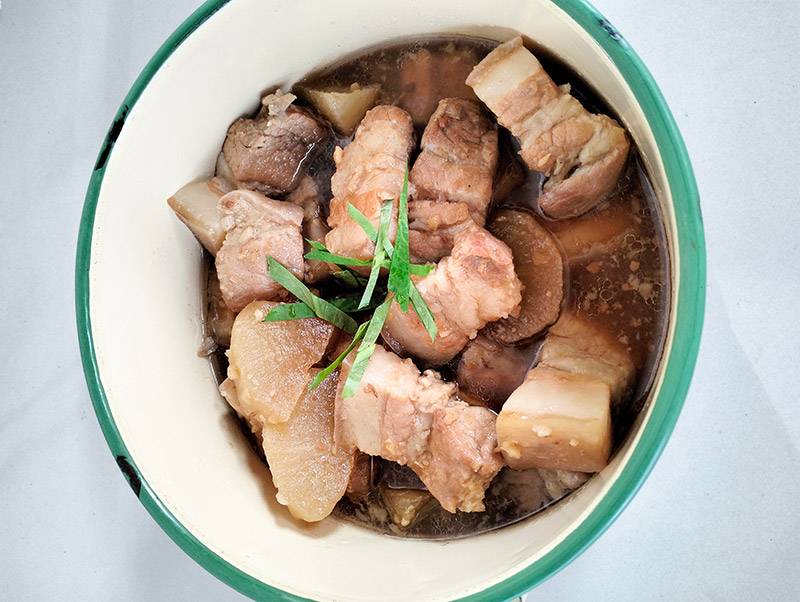
Red Miso vs. White Miso: Which One to Use for Miso Braised Pork Belly?
Miso is a fermented soybean paste. It is widely used in Japanese cuisine. It adds a rich and savory flavor to many dishes, such as soups, sauces, marinades, and glazes. There are different types of miso, each with its own characteristics and uses. We will compare two of the most common varieties: red miso and white miso, and see which one is better for making braised pork belly.
What are red miso and white miso?
Red and white miso are made from soybeans, rice, and salt but differ in proportions and fermentation times. Red miso has more soybeans and less rice than white miso, and it is fermented for a longer time, sometimes up to three years.
This gives red miso a darker color, a saltier taste, and a stronger aroma than white miso, which is fermented for a shorter period, between one week and six months. White miso has a lighter color, a sweeter taste, and a milder aroma than red miso.

How do they affect the flavor of miso braised pork belly?
You can use white or red miso for braised pork belly, depending on your preference. White miso will give the dish a lighter and fresher touch, while red miso will add more depth and richness to the sauce. Red miso may also darken the color of the dish more than white miso.
Some think red miso will overpower their dish, so they mostly use sugar and mirin to balance the flavor. It does not matter; each has its own pros and cons. Use whatever you got in your kitchen. Keep improvising.
Inside the Dish: Exploring the Ingredients of Miso Braised Pork Belly with Daikon
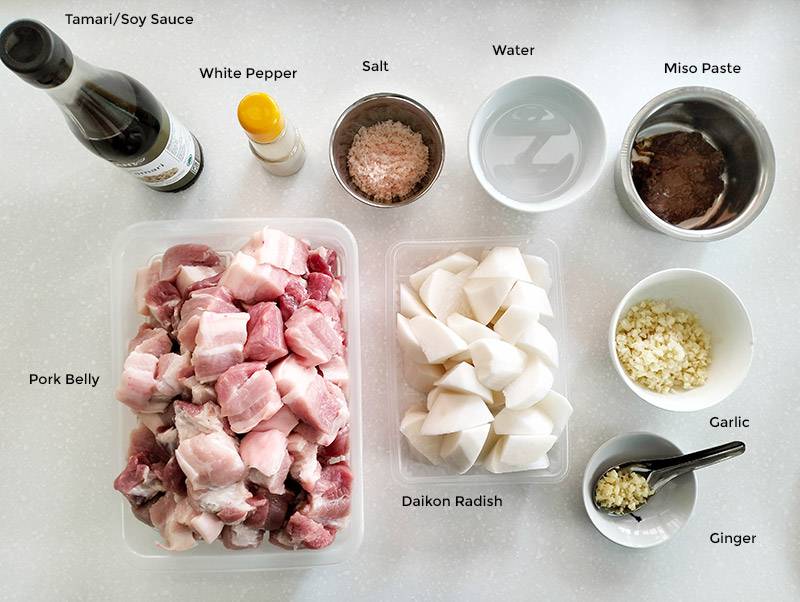
Let’s dive into this mouthwatering adventure together—miso braised pork belly with daikon radish. We’ll start with a tender pork belly, known for its irresistible flavor. A sprinkle of salt and white pepper enhances its natural goodness.
Now, allow me to introduce my trusty sidekick, Mr. Daikon Radish. This humble root vegetable is here to elevate the sweetness of the entire dish. Then, we’ll take fresh ginger and garlic and create a tantalizing mixture by combining them with the miso.
This magical blend will infuse the pork belly with aromatic notes and a complexity that will leave you craving more. These cooking steps are based on my Most Comprehensive Guide on Braising Pork Belly. However, Sometimes you will find variations here and there in my braising recipes. They are actually based on the same basic.
Replacement or Optional Ingredients
If you opt for red miso in your braising, feel free to include mirin and sugar, as I explained earlier. For Daikon replacement, use regular carrots instead. Don’t worry if you don’t have soy sauce or Tamari on hand; it’s absolutely fine!
Preparing the Pork Belly
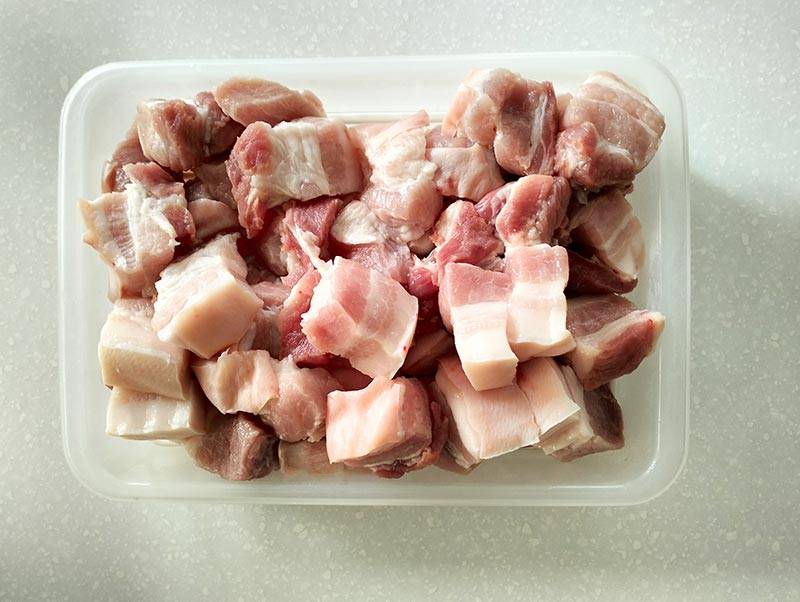
Preparing the Pork belly is easy. Now it’s time to give it some attention. Begin by gently rinsing it under cool water, ensuring it’s squeaky clean. Then, carefully pat it dry with paper towels until it’s nice and dry.
Next, grab a sharp knife and slice the pork belly into thick pieces, each about 1 inch in width. This step makes sure that the meat cooks evenly and stays juicy and tender.
Once the pork belly is sliced, it’s time to add some flavor. Sprinkle with a bit of salt and a touch of white pepper. Cover both sides of the meat, allowing the seasonings to work their magic. Let the seasoned pork belly sit for around 10 minutes if time allowed, allowing the flavors to seep into every delicious bite.
Stir Frying the Pork Belly
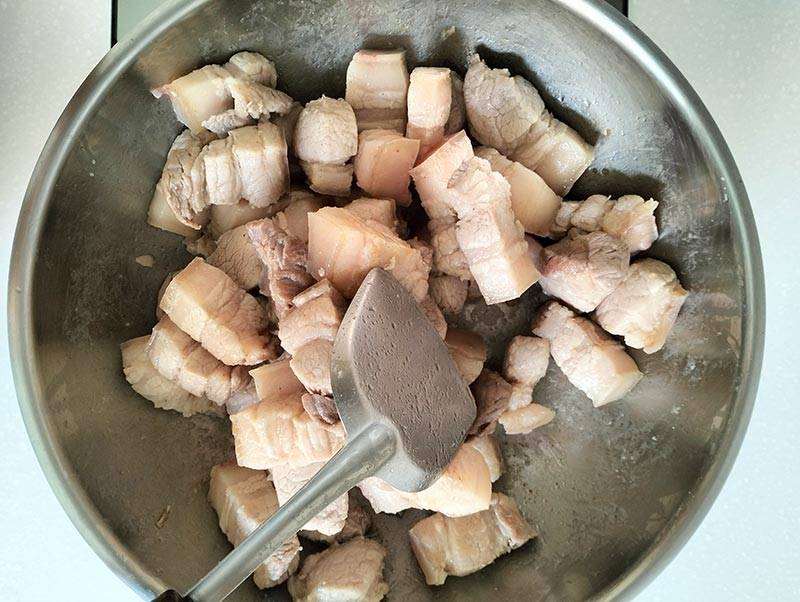
I chose the stir-frying method because it aligns perfectly with our Japanese cuisine theme. Well, just kidding! Typically, at this stage, most Asian recipe cookbooks recommend blanching the meat, while most Western recipes suggest searing it. But guess what? I have a different method to share with you: stir-frying!
This unique approach serves the same purpose as blanching and searing, as it helps eliminate any strong odors. The only difference is that we won’t achieve a golden brown color on the pork belly. However, the main advantage here is the significant time-saving and the added benefit of keeping your home kitchen less messy and greasy. After all, we’re focusing on easy and quick home cooking.
Preparing the Flavorful Mixture
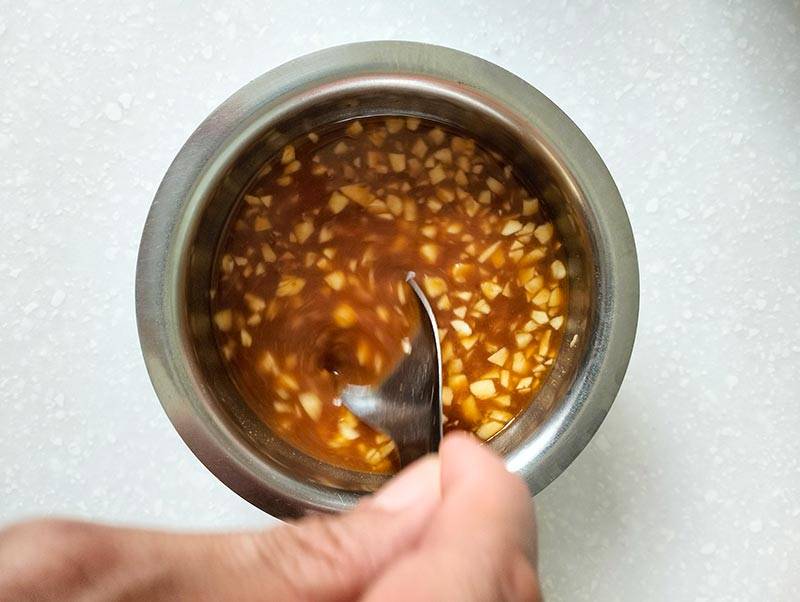
Now it’s time to create the delicious flavor infusion. Combine the red miso paste, minced ginger, garlic, and water in a bowl. Once the pork belly is stir-fried to perfection, pour the flavor-packed mixture over it.
Make sure every piece gets coated with this delectable blend. The miso, ginger, and garlic will work their magic, infusing the meat with enticing aromas and enhancing its taste. Let the pork belly simmer in this flavorful mixture, allowing it to soak up all the deliciousness.
Braising the Miso mixture, Pork Belly, and Daikon Together
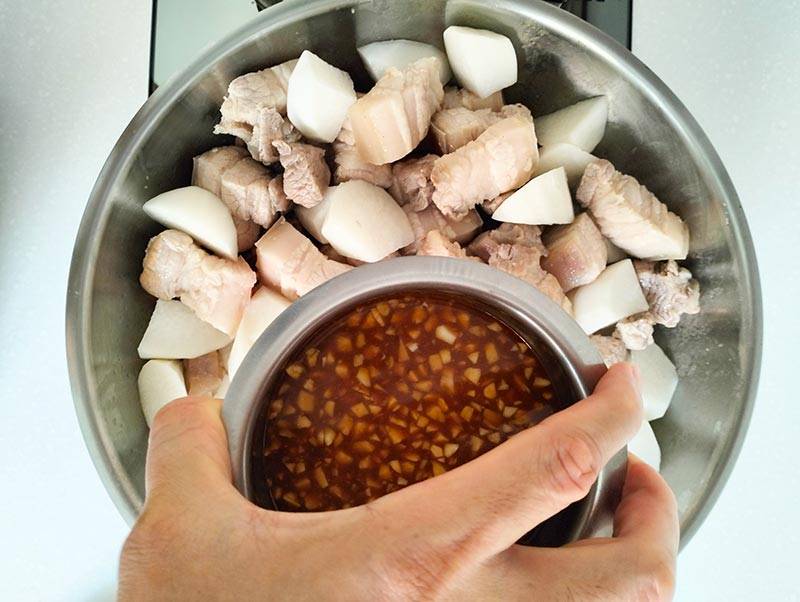
Incorporate the daikon chunks into the skillet, submerging them in the braising liquid. The braising liquid should cover at least two-thirds of the meat. Then, bring the liquid to a gentle simmer.
Cover the Skillet with a Lid
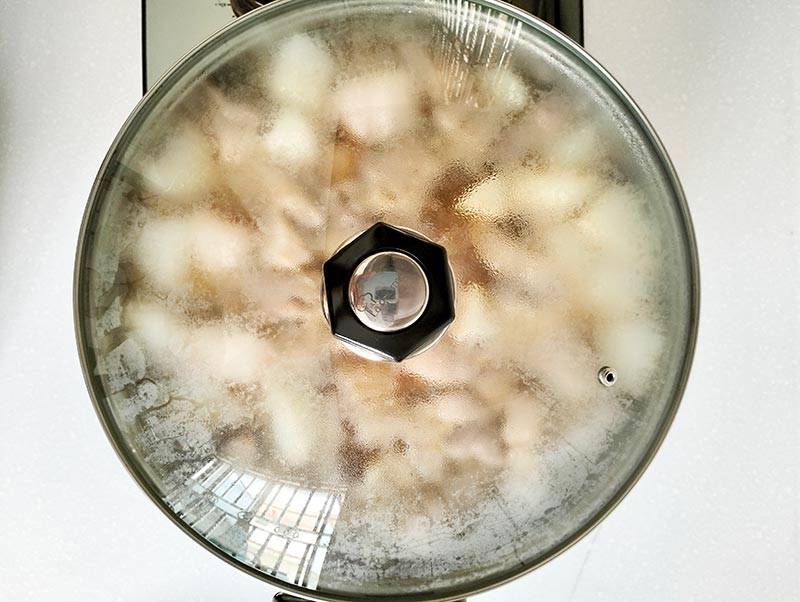
Simply cover the skillet with a lid and cook. Let the pork belly and daikon braise for roughly 1 hour and 15 minutes or until the meat reaches your desired level of tenderness. Some people like it is a bit chewy, and some prefer it to be fork tendered. I like the first chewy one. What about you?!
Final Steps
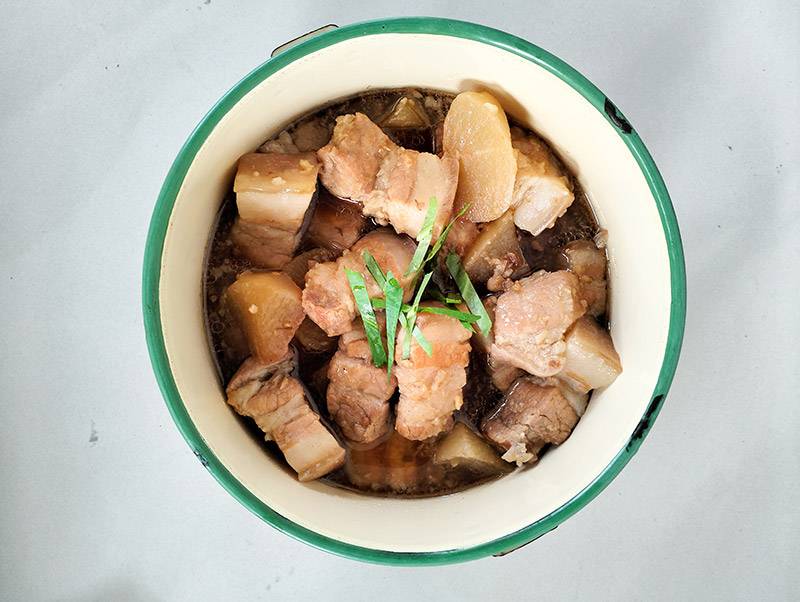
- Once the pork belly and Daikon are cooked to desired tenderness, carefully remove them from the skillet and place them on a serving dish.
- Optionally, you can strain the braising liquid and reduce it to a thicker consistency, then pour it over the pork belly and Daikon.
- Garnish with chopped green onions or cilantro for added freshness and color.
- Serve the Miso Braised Pork Belly with Daikon hot alongside steamed rice or as a part of a larger meal.
Note: Adjust cooking times and ingredient quantities based on personal preferences and desired flavors. Braising the Daikon with the pork belly will result in a softer texture for the Daikon, enhancing the overall dish. Thank you for reading. And, if you want to try something different using miso, check out “Coconut Milk Braised Pork Belly with Miso: A Fusion Recipe.”
Recipe Card
Easy Miso Braised Pork Belly with Daikon
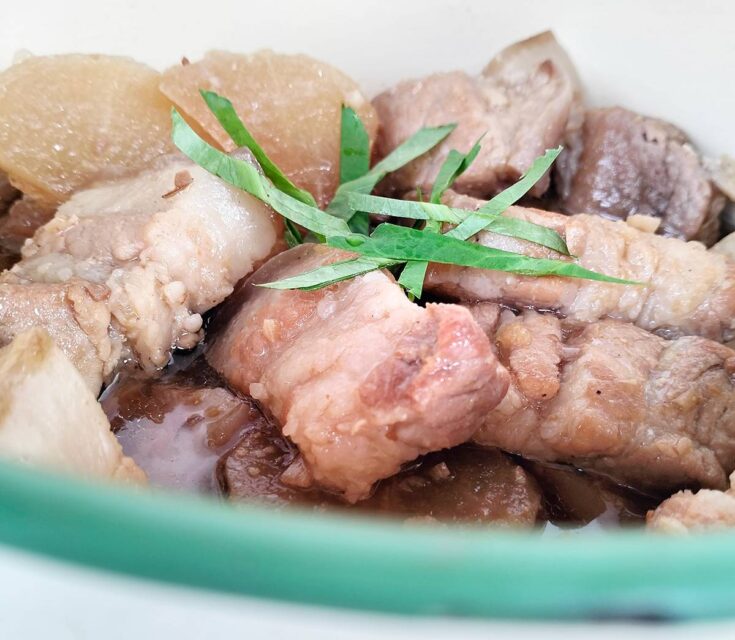
Get ready to tantalize your taste buds with our Easy Miso Braised Pork Belly with Daikon recipe. This dish combines the melt-in-your-mouth tenderness of pork belly with the rich umami flavors of miso, creating a culinary masterpiece.
Ingredients
- Pork Belly 2lbs/1 kg
- Daikon Radish 300 gram
- Salt 1 teaspoon
- White Pepper 1 teaspoon
- Garlic 6 gloves
- Ginger 1 tablespoon
- Miso 3 tablespoon
- Tamari 2 tablespoon
Instructions
- Cut the pork belly into 1 inch thick.
- Season the pork belly with salt and white pepper.
- Add cooking oil. Stir-frying the pork belly until the color changed to white.
- Mix garlic, ginger, miso, Tamari, and water in a bowl.
- Add the miso mixture into the skillet.
- Simmer for approximately 75 minutes.
- Taste the soup or the sauce. Put in more salt or soy sauce if needed.
- Garnished. Mission Completed.
Notes
If you opt for red miso in your braising, feel free to include mirin and sugar.
Daikon radish can be replaced by carrots.
Don't worry if you don't have soy sauce or Tamari on hand; it's absolutely fine!
Nutrition Information
Yield
5Serving Size
1Amount Per Serving Calories 627Total Fat 44gSaturated Fat 16gTrans Fat 0gUnsaturated Fat 26gCholesterol 168mgSodium 1404mgCarbohydrates 7gFiber 2gSugar 2gProtein 49g





